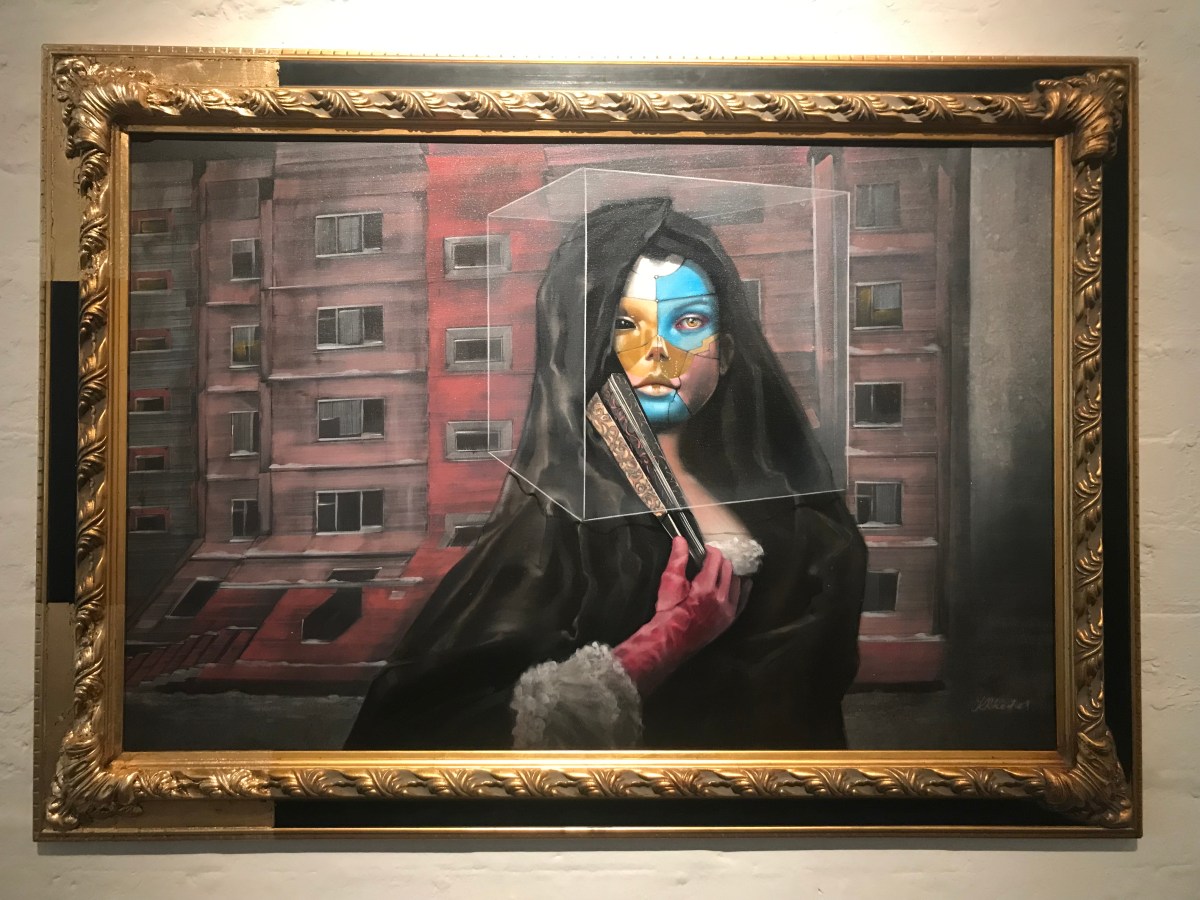As you go from artwork to artwork in Katrina Rhodes’ new exhibition Prescription Windows and Magic Beans, little literary snippets are offered throughout. The purpose of these snippets doesn’t seem to be to explain the artworks; rather, they seem to be literary translations of the visual pieces that they sit next alongside.
Or are they simply insights into the genesis of the pieces? Here are two examples for you to decide for yourself – ‘Prescription windows are the unseen hem that help us fathom our own brainstorming’ … ‘Magic beans are omnipresent if we can germinate our own perspectives and bottle the things we can not explain’. Welcome to the deliciously cryptic world of Katrina Rhodes, one of the two artists now featuring in the exhibition space at fortyfivedownstairs.
Her works in this exhibition are like portraits of regal and affluent individuals (only having one subject per painting contributes to the feeling of a commissioned, royal portrait), but they wear a glass cube – the “prescription windows” – on their heads, and their faces are adorned, in various patterns, with a shade of light blue.
The subjects range from European-style royalty to Japanese geishas, including the one in Indigo, Indigoing, Indigone, sitting in what looks like a budget 1970s highway-side motel room.
The quality of Rhodes’ art is that of a long-established name; in fact she calls herself a “re-emerging artist” because she’s been too busy with contracts and commissions to put together an exhibition for 12 years. What she’s been doing for the past couple of decades is unbelievably intriguing, seeing as some of it included painting palaces in the Ukraine, which her bio describes as ‘surreal’.
Influences from these experiences have crept into her work; for instance, the prevalence of royal-looking subjects and the genre of portraiture. Uniquely, painting outdoor structures like palaces means that she now comfortably uses outdoor paints in her works – all the works in this exhibition are ‘acrylics and oil scumble glaze on cotton’.
Personal highlights are the pieces Incognito and The Hallways Wander Her, due to the striking use of colour to separate the subject from their surroundings in both works and also their composition. Rhodes seems to use variations of the so-called “rule of three” photographic technique, in which a photo or painting is invisibly divided into three sections, and the subject is placed in one of the side thirds instead of the centre of the photograph/painting.
Whether or not Rhodes is using this idea consciously or not (it’s in a few of her works), she appears to play around with it, turning it into a rule of four in The Hallways Wander Her and a rule of six in Incognito, so that the latter’s subject is noticeably uncentred, which gives the image a cinematic feel that it simply wouldn’t have if the subject was centred. Rhodes’ intuition of where to compositionally place the subject adds greatly to their impact on the viewer, whether the viewer is aware of it or not.
In her own words, Rhodes’ work ‘exhibits the leftover dreams found under one’s bed … where there is magic in antithesis’.
In the room next door to Rhodes’ art, there is an extraordinarily different collection of art, yet somehow complementary to hers, that of Stephen (Stefano) Ives, an English-born multimedia artist whose sculptures scream from the plinths that they sit on.
The first one as you enter the room, Carnage, is a triple-armed, triple-breasted equine version of Kali, tank treads and barbed wire in her hair, a cobra for a tail and crushing a tank with a single hoof.
As eye-opening as this sculpture is, it’s an entrée compared to the barely-describable mix of horse, skeletal pilot and burning, nose-diving aircraft that sits behind it, made from an eclectic mix of materials, as if Ives had gone to a model shop, picked up some models from the WWII, Tolkein and robot manga sections, watched Akira and Howl’s Moving Castle a few times and went from there.
The result is both fluid and organic, and mechanical, yet not biomechanical – they are interlinked, but not interwoven, which successfully gives the work two separate textures, two separate worlds.
According to his bio, Ives works with a mix of ‘bricolaged plastics, toys and found objects’, and the results show incredible creativity and are of meticulous quality.
Read: Exhibition review: George Gittoes: Ukraine Guernica, Hazelhurst Arts Centre
Ives’ and Rhodes’ works complement each other extremely well, not because they’re particularly similar, nor fittingly juxtaposing, but because both are masters of the visual languages that they speak.
Katrina Rhodes: Prescription Windows and Magic Beans and Stephen (Stefano) Ives: Chained to an Idiot will be exhibited at Fortyfivedownstairs until 15 June 2024. Free entry.





